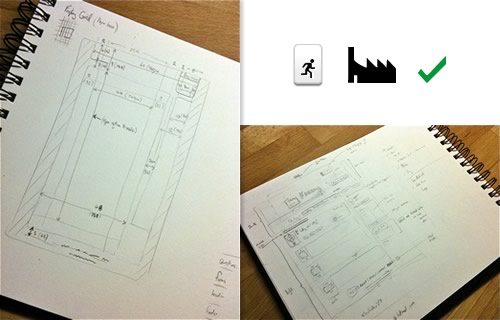NOTE: Apparently there are issues with this code and the latest Paperclip gem (currently 2.3.4) – its down to the use of reprocess and this known issue i’m currently looking at a work around here’s a patch fix
I use Paperclip for pretty much all upload processing. Its flexible, fast and easily extendable. One particular feature that has cropped up (a couple of times now) – has been the ability to edit and update the contents of uploaded files. For example; editing css, html or javascript in a CMS. Something I’ve needed for Bugle
In the past I struggled getting this to work with Paperclip. You’ll find me rambling to myself in the mailing list almost a year ago. I figured the Shopify guys we’re doing this in their app, so it had to be possible.
One solution, was to simply read the file contents (on create) from the uploaded file into a database column. Then on future requests for the file, serve it virtually from the database; through a Rails controller/action responding with the appropriate content type and content data.
But, this meant the Rails app would be handling all the css/js requests in the CMS. I really wanted to serve these uploaded files from S3/Cloudfront making full use of Amazon’s CDN. So I set about building a Paperclip::Processor to store the file contents (in the database) on create then on update, update contents and re-upload the file again. To work with cache expiry in the CDN I could use the updated_on timestamp in the URL to the file.
Here’s most of the code below, i’ve also created a git repository with a working simple app. I’m using a RESTful UploadsController with an Upload model. The model has an Paperclip attachment (asset) and the file contents (for editable files) are stored in a TEXT column (‘asset_contents’ in the database).
Controller
Nothing crazy going on here, just straight forward RESTful controller logic (without a show action)
class UploadsController < ApplicationController
def index
@uploads = Upload.scoped
end
def new
@upload = Upload.new
end
def edit
@upload = Upload.find(params[:id])
end
def create
@upload = Upload.new(params[:upload])
if @upload.save
flash[:notice] = 'Upload was successfully created'
redirect_to uploads_url
else
render 'new'
end
end
def update
@upload = Upload.find(params[:id])
if @upload.editable? && @upload.update_attributes(params[:upload])
flash[:notice] = 'Upload was successfully updated'
redirect_to uploads_url
else
render 'edit'
end
end
def destroy
@upload = Upload.find(params[:id])
if @upload.destroy
flash[:notice] = 'Upload was successfully deleted'
end
redirect_to uploads_url
end
endModel
Two things to notice here. I’m using lambda’s on the style and processor attributes. In both cases they check the content-type to see if the file is either editable or thumbnailable. If it is a thumbnailable image, I give it a thumbnail style and the thumbnail (default) Paperclip::Processor. For editable files, I give it a style for the original file only, and use the new FileContents Processor (see below). The style hash sets which database column will be used for storing the file contents, in this case it’s the ‘asset_contents’ attribute.
Second is the after_update hook. When thew Upload model gets saved, I want Paperclip to reprocess the asset again. This ensures that when the asset is saved on update the FileContents processor executes. The thumbnailable? and editable? methods let you decide what file types should be considered for processing.
class Upload < ActiveRecord::Base
after_update :reprocess
has_attached_file :asset, :styles => lambda { |a|
if a.instance.thumbnailable?
{:thumb => ["64x64#", :jpg]}
elsif a.instance.editable?
{:original => {:contents => 'asset_contents'}}
end
},
:path => "/:id/:style/:basename.:extension",
:storage => :s3,
:s3_credentials => "#{Rails.root}/config/s3.yml",
:bucket => "paperclip-example-bucket-#{Rails.env}",
:processors => lambda { |a|
if a.editable?
[:file_contents]
elsif a.thumbnailable?
[:thumbnail]
end
}
attr_protected :asset_file_name, :asset_content_type, :asset_size
validates_attachment_size :asset, :less_than => 6.megabytes
validates_attachment_presence :asset
def editable?
return false unless asset.content_type
['text/css', 'application/js', 'text/plain', 'text/x-json', 'application/json', 'application/javascript',
'application/x-javascript', 'text/javascript', 'text/x-javascript', 'text/x-json',
'text/html', 'application/xhtml', 'application/xml', 'text/xml', 'text/js'].join('').include?(asset.content_type)
end
def thumbnailable?
return false unless asset.content_type
['image/jpeg', 'image/pjpeg', 'image/gif', 'image/png', 'image/x-png', 'image/jpg'].join('').include?(asset.content_type)
end
private
def reprocess
asset.reprocess! if editable?
end
end
FileContents Paperclip::Processor
This processor basically reads the uploaded file contents on create and sets the asset_contents attribute. On update, it creates a new Tempfile with its content from the asset_contents attribute and then returns this Tempfile for Paperclip uploading. Comments in the code below explain further, (place this file in lib/paperclip/file_contents.rb).
module Paperclip
class FileContents < Processor
def initialize file, options = {}, attachment = nil
@file = file
@options = options
@instance = attachment.instance
@current_format = File.extname(attachment.instance.asset_file_name)
@basename = File.basename(@file.path, @current_format)
@whiny = options[:whiny].nil? ? true : options[:whiny]
end
def make
begin
# new record, set contents attribute by reading the attachment file
if(@instance.new_record?)
@file.rewind # move pointer back to start of file in case handled by other processors
file_content = File.read(@file.path)
@instance.send("#{@options[:contents]}=", file_content)
else
# existing record, set contents by reading contents attribute
file_content = @instance.send(@options[:contents])
# create new file with contents from model
tmp = Tempfile.new([@basename, @current_format].compact.join("."))
tmp << file_content
tmp.flush
@file = tmp
end
@file
rescue StandardError => e
raise PaperclipError, "There was an error processing the file contents for #{@basename} - #{e}" if @whiny
end
end
end
end
Views
The view code is simple, a new and edit form with a textarea for contents editing.
# uploads/new.html.erb
<%= form_for(:upload, :url => uploads_path,
:html => { :method => :post, :multipart => true }) do |f| %>
<input type="file" name="upload[asset]"> <%= f.submit 'upload', :disable_with => 'uploading ...' %>
<% end %>
# uploads/edit.html.erb
<%= form_for @upload do |f| %>
<%= f.text_area :asset_contents, :rows => 20, :cols => 100, :id => 'file_asset_contents' %>
<p><%= f.submit 'Save changes', :disable_with => 'saving ...' %></p>
<% end -%>
# reference upload URL always with timestamp
<%= @upload.asset.url(:original, true) %>
Some gotchas
If you are using an Amazon S3 bucket, make sure you set it to be ‘world’ readable, so your uploaded files are publicly accessible. Also, the file_contents.rb processor should live in lib/paperclip/file_contents.rb. And for a Rails 3 add this to your load path, in config/application.rb
config.autoload_paths += %W(#{Rails.root}/lib)I’ve been running this code with no issues in production for some time now. I should point out that I limit these editable uploads to ~3Mb-6Mb and you may have performance issues with larger files. Some solutions could be to use delayed_job (or something similar) to background process the task, and/or change the processor code to read/write one line at a time.




